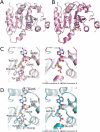Structural model of the M7G46 Methyltransferase TrmB in complex with tRNA
- PMID: 34006170
- PMCID: PMC8632124
- DOI: 10.1080/15476286.2021.1925477
Structural model of the M7G46 Methyltransferase TrmB in complex with tRNA
Abstract
TrmB belongs to the class I S-adenosylmethionine (SAM)-dependent methyltransferases (MTases) and introduces a methyl group to guanine at position 7 (m7G) in tRNA. In tRNAs m7G is most frequently found at position 46 in the variable loop and forms a tertiary base pair with C13 and U22, introducing a positive charge at G46. The TrmB/Trm8 enzyme family is structurally diverse, as TrmB proteins exist in a monomeric, homodimeric, and heterodimeric form. So far, the exact enzymatic mechanism, as well as the tRNA-TrmB crystal structure is not known. Here we present the first crystal structures of B. subtilis TrmB in complex with SAM and SAH. The crystal structures of TrmB apo and in complex with SAM and SAH have been determined by X-ray crystallography to 1.9 Å (apo), 2.5 Å (SAM), and 3.1 Å (SAH). The obtained crystal structures revealed Tyr193 to be important during SAM binding and MTase activity. Applying fluorescence polarization, the dissociation constant Kd of TrmB and tRNAPhe was determined to be 0.12 µM ± 0.002 µM. Luminescence-based methyltransferase activity assays revealed cooperative effects during TrmB catalysis with half-of-the-site reactivity at physiological SAM concentrations. Structural data retrieved from small-angle x-ray scattering (SAXS), mass-spectrometry of cross-linked complexes, and molecular docking experiments led to the determination of the TrmB-tRNAPhe complex structure.
Keywords: 7-methylguanosine; Trna modification; m7G; trm8; trmb.
Figures







Similar articles
-
The core domain of Aquifex aeolicus tRNA (m7G46) methyltransferase has the methyl-transfer activity to tRNA.Nucleic Acids Symp Ser (Oxf). 2006;(50):245-6. doi: 10.1093/nass/nrl122. Nucleic Acids Symp Ser (Oxf). 2006. PMID: 17150909
-
Crystal structure of Bacillus subtilis TrmB, the tRNA (m7G46) methyltransferase.Nucleic Acids Res. 2006 Apr 5;34(6):1925-34. doi: 10.1093/nar/gkl116. Print 2006. Nucleic Acids Res. 2006. PMID: 16600901 Free PMC article.
-
Molecular mechanism of tRNA binding by the Escherichia coli N7 guanosine methyltransferase TrmB.J Biol Chem. 2023 May;299(5):104612. doi: 10.1016/j.jbc.2023.104612. Epub 2023 Mar 16. J Biol Chem. 2023. PMID: 36933808 Free PMC article.
-
Trm5 and TrmD: Two Enzymes from Distinct Origins Catalyze the Identical tRNA Modification, m¹G37.Biomolecules. 2017 Mar 21;7(1):32. doi: 10.3390/biom7010032. Biomolecules. 2017. PMID: 28335556 Free PMC article. Review.
-
7-Methylguanosine Modifications in Transfer RNA (tRNA).Int J Mol Sci. 2018 Dec 17;19(12):4080. doi: 10.3390/ijms19124080. Int J Mol Sci. 2018. PMID: 30562954 Free PMC article. Review.
Cited by
-
A Comprehensive Analysis of METTL1 to Immunity and Stemness in Pan-Cancer.Front Immunol. 2022 Mar 31;13:795240. doi: 10.3389/fimmu.2022.795240. eCollection 2022. Front Immunol. 2022. PMID: 35432338 Free PMC article.
-
The functions and mechanisms of RNA modification in prostate: Current status and future perspectives.Front Genet. 2024 May 10;15:1380746. doi: 10.3389/fgene.2024.1380746. eCollection 2024. Front Genet. 2024. PMID: 38798700 Free PMC article. Review.
-
Structures and mechanisms of tRNA methylation by METTL1-WDR4.Nature. 2023 Jan;613(7943):383-390. doi: 10.1038/s41586-022-05565-5. Epub 2023 Jan 4. Nature. 2023. PMID: 36599982 Free PMC article.
-
The role of RNA modification in hepatocellular carcinoma.Front Pharmacol. 2022 Sep 2;13:984453. doi: 10.3389/fphar.2022.984453. eCollection 2022. Front Pharmacol. 2022. PMID: 36120301 Free PMC article. Review.
-
Structural basis of regulated m7G tRNA modification by METTL1-WDR4.Nature. 2023 Jan;613(7943):391-397. doi: 10.1038/s41586-022-05566-4. Epub 2023 Jan 4. Nature. 2023. PMID: 36599985 Free PMC article.
References
-
- Okamoto S, Tamaru A, Nakajima C, et al. Loss of a conserved 7-methylguanosine modification in 16S rRNA confers low-level streptomycin resistance in bacteria. Mol Microbiol. 2007. Feb.;63(4):1096–1106. - PubMed
Publication types
MeSH terms
Substances
LinkOut - more resources
Full Text Sources
Other Literature Sources
Molecular Biology Databases
